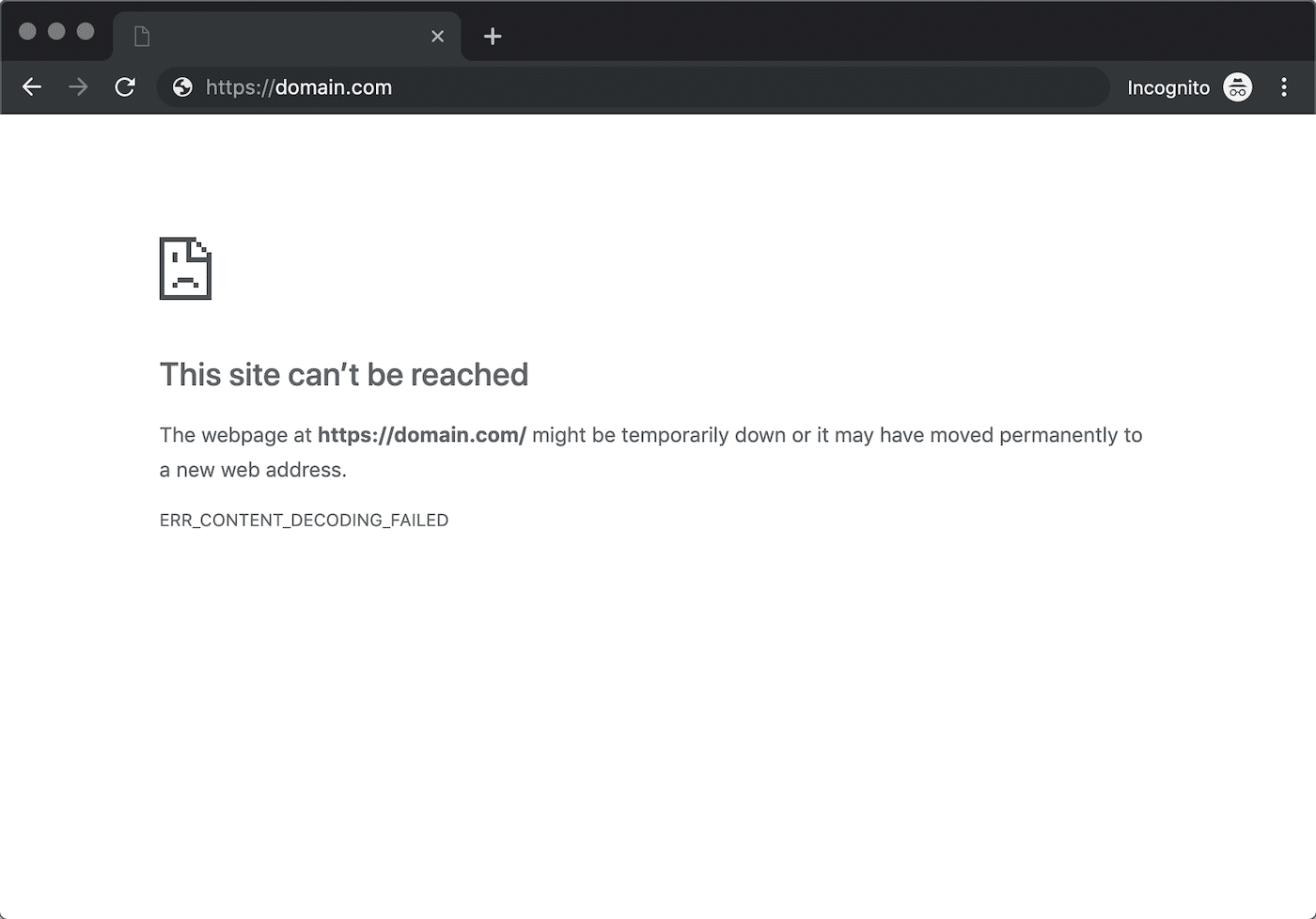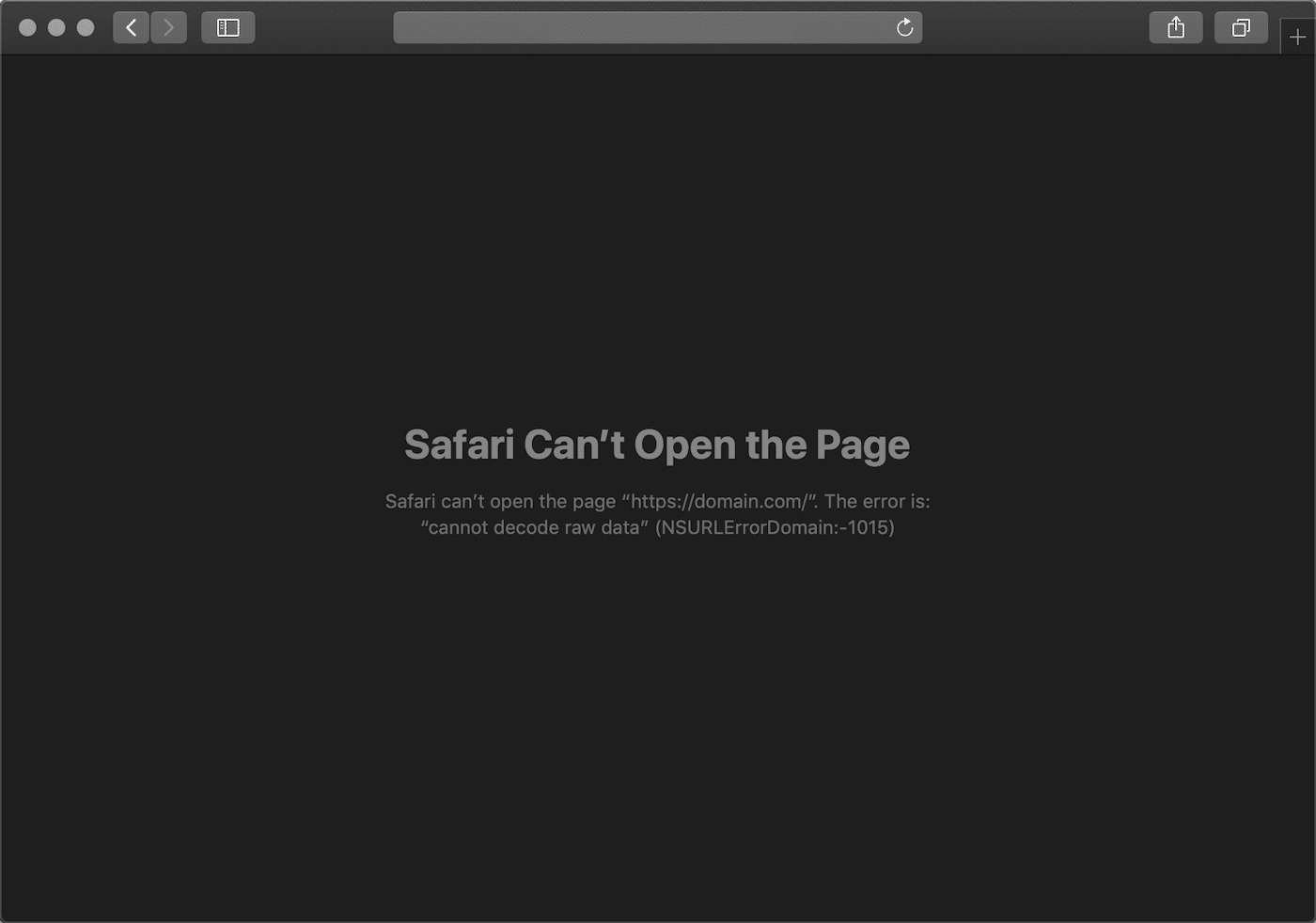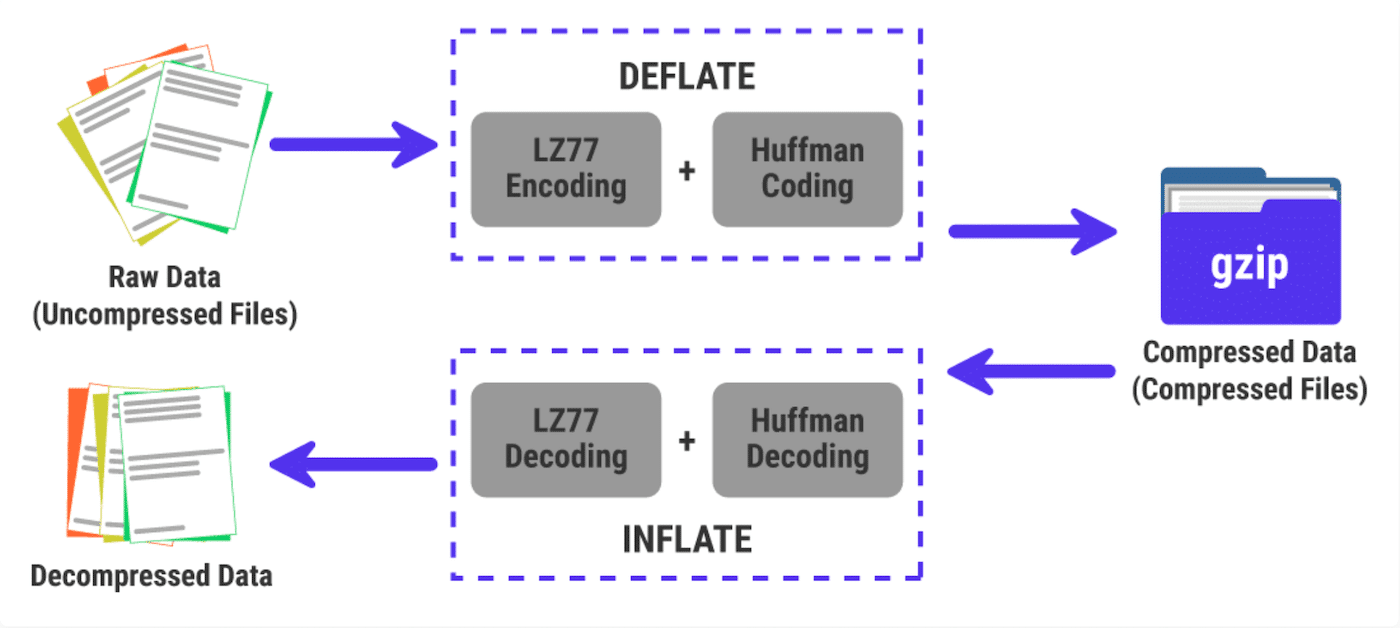The good news is that the ERR_CONTENT_DECODING_FAILED error is quite easy to fix. As long as you have the patience to try out some troubleshooting tactics, like turning off your firewall or clearing your browser cache, you should be able to resolve the issue without any hassle.
In this article, we’ll take a closer look at the ERR_CONTENT_DECODING_FAILED error and what causes it. Then, we’ll show you six ways to fix it. Let’s get started!
When you’re trying to access a website, you might see an ERR_CONTENT_DECODING_FAILED message. This can be frustrating, as it prevents you from viewing the site:
This error can occur on different browsers, including Google Chrome and Safari:
In order to understand this error, it’s important to know that it’s often dependent upon
GZIP compression
. This type of compression is an easy way to optimize your WordPress website.
In a nutshell, when someone tries to access your site, the browser checks for GZIP compression by looking for the
content-encoding: gzip
response header. If it finds it, it will automatically retrieve the compressed files, decompress them, and deliver them to the user:
If something goes wrong during this process (and there are lots of possibilities here), you’ll get the ERR_CONTENT_DECODING_FAILED error.
What Causes the ERR_CONTENT_DECODING_FAILED Error?
Now that you know what the ERR_CONTENT_DECODING_FAILED error is, let’s explore some of its common causes:
Firewalls
. This security feature can protect you from Distributed Denial of Service (DDoS) attacks, brute force attacks, malware, and more. However, it can also confuse your browser and trigger the ERR_CONTENT_DECODING_FAILED error.
Corrupt cache or cookies
. A browser cache can come in handy when you want your content delivered faster. Meanwhile,
cookies
can be crucial for affiliate marketing. However, if you don’t
clear your cache
from time to time, outdated or corrupt content can cause issues with your browser.
Encoding error
. As we mentioned earlier, GZIP compression can lead to some issues. You might also see this error simply because your HTTP request header is showing that the website material is encoded when it’s really not.
Incorrect DNS address
. If your DNS addresses aren’t accurate, this might also lead to the ERR_CONTENT_DECODING_FAILED error.
DNS settings
. As with caching, your
DNS configurations
can become outdated or corrupt.
These are just a few common causes of the ERR_CONTENT_DECODING_FAILED error. As you can see, some are quite easy to resolve, while others will require a bit more work. In the next section, we’ll show you how to tackle these problems.
How To Fix the ERR_CONTENT_DECODING_FAILED Error (6 Methods)
Now, let’s explore six ways you can resolve the ERR_CONTENT_DECODING_FAILED error. While it can appear in several different browsers, we’re going to work exclusively with Google Chrome, since it’s the
most popular browser on the market
.
1. Disable Any Active Firewalls
A firewall can protect your device from online threats. However, it can also cause the ERR_CONTENT_DECODING_FAILED error.
You can check to see if this is the case by disabling the firewall. First, let’s see how to do this on a Mac device.
To get started, go to
System Preferences > Security & Privacy
. Then, navigate to the
Firewall
tab:
Firewall settings on a Mac device
At this point, you may see your firewall is off. However, if it is on, select the lock in the bottom left corner of the window.
You’ll be prompted to enter your password before you can continue. Then, you’ll be able to modify your security settings.
Select
Turn Off Firewall
and click on the lock again to save your changes:
Turning off firewall settings
On a Windows device, the process is just as easy. You’ll need to go to
Control Panel
> System > Privacy & security.
Then, select
Windows Security
and click on
Firewall & network protection
to manage your firewalls:
Managing the firewalls in Windows
When you’re ready, return to your browser and check to see if this has resolved the issue.
2. Clear Your Browser Cache and Cookies
If you’re still getting the ERR_CONTENT_DECODING_FAILED message, the issue may be with your
cached data
. Caching can speed up content delivery, but if you don’t
clear out your browser cache
every once in a while, it can create complications.
Cookies
can also be problematic. So, let’s look at how to wipe them out along with the cache.
Open Google Chrome and click on the three dots in the upper right-hand corner of your screen. Then go to
More Tools > Clear Browsing Data
:
Google Chrome settings
You’ll now see the following pop-up window:
Clearing browsing data in Google Chrome
To be safe, we recommend choosing
All time
for your time range. Then, make sure to select
Cookies and other site data
as well as
Cached images and files
.
Hit
Clear data
and return to the web page that was giving you the ERR_CONTENT_DECODING_FAILED error. If it’s still not loading, you can move on to the next step!
3. Disable GZIP Encoding
GZIP compression can be a great way to improve a website’s performance. However, if something goes wrong during the compression process, it may trigger an ERR_CONTENT_DECODING_FAILED error.
So, we’re going to show you how to disable GZIP encoding. To do this, you’ll need to use a
Chrome extension
like
ModHeader – Modify HTTP headers
. Simply go to the extension page and select
Add to Chrome
:
ModHeader – Modify HTTP headers
You’ll then see a pop-up alert notifying you that this extension can read and change data on your websites. Click on
Add extension
to continue.
This will automatically open the ModHeader dashboard, but you can go ahead and close this screen. Instead, click on the ModHeader icon next to your navigation bar:
ModHeader Request headers settings
Under Request Headers, locate the empty field for Name and enter accept-encoding. Then, in the Value field, input gzip;q=0,deflate;q=0 (as shown below):
Disabling GZIP compression in Google Chrome
Now, GZIP compression has been disabled in your browser. Simply return to the page that was throwing the ERR_CONTENT_DECODING_FAILED error to see if it’s working. If it’s still not fixed, you may want to
remove this chrome extension
and proceed to the next step.
4. Manually Configure Your DNS Server Addresses
Your
Domain Name System (DNS)
configuration can be another possible reason you’re getting the ERR_CONTENT_DECODING_FAILED error message. Therefore, you might want to change your DNS server addresses to see if this solves the problem.
Chances are your current device is running the default settings provided by your
Internet Service Provider (ISP)
, but don’t worry, they are easy to modify. In any case, remember to take note of your original server address, just in case you want to revert back to it.
On a Mac device, start by going to
System Preferences > Network
. Make sure
Wi-Fi
is selected and hit
Advanced
. Then, navigate to the
DNS
tab:
Default DNS server addresses in Mac settings
Now we’re going to replace this server address with
Google’s Public DNS
. To do this, simply click on the
+
icon in the bottom left-hand corner.
Then, enter
8.8.8.8
and/or
8.8.4.4
. These are Google’s IPv4 addresses:
Changing default DNS to Google’s Public DNS server on Mac
Alternatively, you can enter Google’s IPv6 addresses. Finally, click on
OK
to save your changes.
On a Windows device, open the
Settings
app and select
Network and Internet
. Then, click on
Properties:
Network & Internet settings in Windows
On the next page, locate
IP Assignment
and click on the
Edit
button:
IP assignment in Windows
This will launch a popup window. Choose
Manual
, then turn on the toggle switch for
IPv4.
Enter the IP address in the appropriate field and hit
Save
:
Changing the IP address in Windows
If you have trouble with this process, you may want to check out
Google’s detailed guide
on changing your DNS server addresses to its public DNS.
5. Flush Your DNS
If reconfiguring your DNS server addresses didn’t resolve your browser issue, it may be time to
flush your DNS
entirely. To do this on a Mac, you’ll need to use Terminal.
You can look for this application using the Spotlight Search tool:
Terminal on a Mac
Once you have Terminal open, enter the following command and hit enter:
sudo dscacheutil -flushcache; sudo killall -HUP mDNSResponder
You’ll then need to input your admin password. Click on enter again and you should see a confirmation that your DNS has been flushed.
On Windows, the process is equally simple. You’ll need to open the Command Prompt application and input the following:
ipconfig /flushdns
Now, return to the page in question to see if it’s still showing the ERR_CONTENT_DECODING_FAILED error.
6. Flush Your Browser’s Socket Pools
If the methods above haven’t worked for you, there’s one more strategy you might want to try. That’s flushing your browser’s socket pools.
Just open a new tab in Chrome and type the following address into your search bar:
chrome://net-internals
. This will take you to the following page:
Google Chrome’s net internals page
Go to
Sockets
in the left-hand menu. Then, click on the
Flush socket pools
button:
Flushing Chrome’s socket pools
Now, return to the page throwing the ERR_CONTENT_DECODING_FAILED message and see if it’s working!
Summary
The ERR_CONTENT_DECODING_FAILED error can show up unexpectedly in your browser. Sometimes this is due to a complex encoding or decoding issue. Other times, the culprit can be something as simple as a firewall or corrupt cache. Regardless, you’ll want to resolve this error as soon as possible.
You can start by turning off any firewalls and clearing your browser cache and cookies. If neither of these strategies works, you might need to disable GZIP encoding, flush your DNS, or manually re-configure your DNS server addresses.
If your business depends on your website, you’ll want to ensure that it’s accessible at all times. At Kinsta, all of
our hosting plans
come with top-quality support to help you troubleshoot any issues that you may encounter.
Get all your
applications
,
databases
, and
WordPress sites
online and under one roof. Our feature-packed, high-performance cloud platform includes:
Easy setup and management in the MyKinsta dashboard
24/7 expert support
The best Google Cloud Platform hardware and network, powered by Kubernetes for maximum scalability
An enterprise-level Cloudflare integration for speed and security
Global audience reach with up to 37 data centers and 260 PoPs worldwide
Get started with a free trial of our
Application Hosting
or
Database Hosting
. Explore our
plans
or
talk to sales
to find your best fit.
Is your WordPress site slow?
Uncover your website's performance bottlenecks to deliver a better user experience.
Free Audit
The “you must call the content function” Elementor error is a page builder specific error. Here are 4 ways to easily fix it.
Reading time
7 min read
Updated date
January 5, 2024
Post type
Knowledge Base
Topic
Website Errors
Launching a blog soon? This in-depth guide goes through the best blogging platforms to help you pick the right one: self-hosted vs hosted.
Reading time
26 min read
Updated date
December 14, 2023
Post type
Topic
Content Strategy
Topic
WordPress Alternatives
Mixed content warnings are common after an HTTPS migration or adding a new service. Check out how to quickly fix these on your site.
Reading time
14 min read
Updated date
September 18, 2023
Post type
Topic
Website Errors
Switch language
© 2013 - 2024 Kinsta Inc. All rights reserved.
Kinsta® and WordPress® are registered trademarks.
Legal information.


